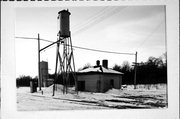Property Record
214 FLEET ST
Architecture and History Inventory
| Historic Name: | Soo Line Railroad Water Tower & Shed |
|---|---|
| Other Name: | Soo Line Railroad Sandhouse |
| Contributing: | |
| Reference Number: | 38331 |
| Location (Address): | 214 FLEET ST |
|---|---|
| County: | Chippewa |
| City: | Chippewa Falls |
| Township/Village: | |
| Unincorporated Community: | |
| Town: | |
| Range: | |
| Direction: | |
| Section: | |
| Quarter Section: | |
| Quarter/Quarter Section: |
| Year Built: | 1909 |
|---|---|
| Additions: | |
| Survey Date: | 1984 |
| Historic Use: | public utility/power plant/sewage/water |
| Architectural Style: | Astylistic Utilitarian Building |
| Structural System: | |
| Wall Material: | Brick |
| Architect: | |
| Other Buildings On Site: | |
| Demolished?: | No |
| Demolished Date: |
| National/State Register Listing Name: | Not listed |
|---|---|
| National Register Listing Date: | |
| State Register Listing Date: |
| Additional Information: | A one-story brick storage structure with a hip roof, sited along the railroad tracks. A simple utilitarian structure of no known architectural significance. This sandhouse was probably constructed sometime around 1909 by the Minneapolis, St. Paul and Sault St. Marie (Omaha). In 1909, the year the Omaha leased the Wisconsin Central, the Omaha made considerable improvements to their yards. It is possible the sandhouse was built at this time. Further research is needed to clarify this construction date. The only extant map, prior to 1924, showing the Soo Yards is from 1888. The sandhouse does not appear on this map. It does appear on the Sanborn Map, 1924. The Omaha Railroad improved these yards following their purchase of a lease from the Wisconsin Central. This sandhouse is of local historical importance because it is associated with Chippewa Falls' peak period of railroad activity. This structure is one of only six structures remaining from this period. It is the only remaining sand dryer. It is important to note that sandhouses of this type were designed for use with steam engines. Steam engines are no longer used commercially, making sandhouses obsolete. It is doubtful whether structures, like this sandhouse, are built today. |
|---|---|
| Bibliographic References: | (A) Roy L. Martin, History of the Wisconsin Central (Boston: The Railroad and Locomotive Historical Society, Inc., 1941), p. 103. (B) Taped Interview with Josephine Burrows, 1976/1977 (Eau Claire, Wisconsin: Chippewa Valley Museum). (C) Sanborn Map, 1924. |
| Wisconsin Architecture and History Inventory, State Historic Preservation Office, Wisconsin Historical Society, Madison, Wisconsin |

